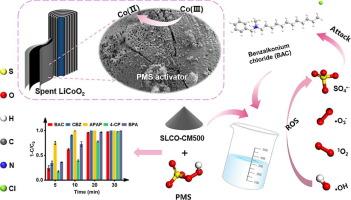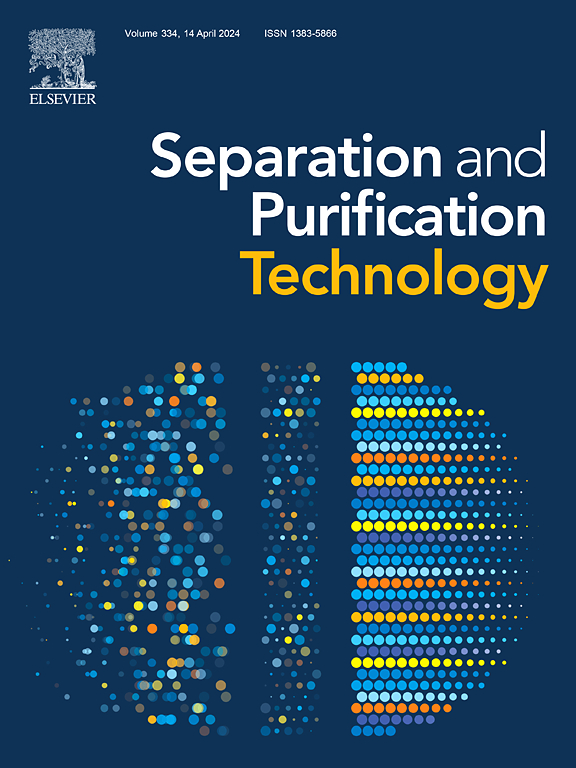废锂离子电池阴极的无损升级回收方法:与有机废水的高效处理相结合
IF 9
1区 工程技术
Q1 ENGINEERING, CHEMICAL
引用次数: 0
摘要
废旧锂离子电池的回收利用一直是全球研究的热点。然而,其低碳发展却很少受到关注。传统的水法/火法回收SLIB依赖于大量的试剂和能源消耗,具有很高的污染风险。在此,我们提出了一种新型的SLIBs循环利用与有机废水处理相结合的策略。与传统的破坏性回收方法不同,该方法利用了slb普遍存在的缺陷和活性位点等独特的特性,实现了新的利用。我们发现SLIBs在过氧单硫酸盐(PMS)活化体系中表现出优异的有机废水处理催化性能。在催化剂0.2 g/L、PMS 2 mM、初始pH = 7的最佳条件下,40 min对苯扎氯铵的降解率可达99 %以上。重要的是,slib对其他典型污染物也有效果,降解率接近99% %。机理表明,SLIBs中Co2+/Co3+的氧化还原大大加速了活性氧的生成,其中SO4−和1O2是催化降解的主要来源。与新鲜的Co3O4相比,SLIBs的降解速率常数是其1.9倍。我们的研究结果突出了SLIBs与其他废物处理耦合回收的潜力,并指导了SLIBs以“废物处理废物”的方式进行高价值利用。本文章由计算机程序翻译,如有差异,请以英文原文为准。


Non-destructive approach for upcycling the cathode of spent lithium-ion batteries: Combined with the efficient treatment of organic wastewater
Recycling spent lithium-ion batteries (SLIBs) has been a global research hotspot. However, its low-carbon development has received little attention. Traditional SLIB recycling through hydro/pyrometallurgy is heavily reagent-dependent and energy-consuming, posing high pollution risk. Here, we propose a novel strategy of recycling SLIBs coupling with organic wastewater disposal. Unlike traditional destructive recycling methods, this method takes advantage of the unique characteristics of SLBs such as pervasive defects and active sites to achieve novel utilization. We find that SLIBs show excellent catalytic performances for organic wastewater disposal in the peroxymonosulfate (PMS) activation system. Under optimal conditions of 0.2 g/L catalyst, 2 mM PMS, and initial pH = 7, the degradation rate of benzalkonium chloride exceeds 99 % at 40 min. Importantly, SLIBs also demonstrate efficacy against other typical pollutants, achieving nearly a 99 % degradation rate. The mechanism demonstrates that the redox of Co2+/Co3+ in SLIBs greatly accelerates the generation of reactive oxygen species, where SO4![]() − and 1O2 are the main contributors for the catalytic degradation. In comparison to fresh Co3O4, SLIBs result in a 1.9-fold degradation rate constant. Our findings highlight potentials of recycling SLIBs coupling with other waste disposal and guide high-value utilization of SLIBs in a “treating waste by waste” way.
− and 1O2 are the main contributors for the catalytic degradation. In comparison to fresh Co3O4, SLIBs result in a 1.9-fold degradation rate constant. Our findings highlight potentials of recycling SLIBs coupling with other waste disposal and guide high-value utilization of SLIBs in a “treating waste by waste” way.
求助全文
通过发布文献求助,成功后即可免费获取论文全文。
去求助
来源期刊

Separation and Purification Technology
工程技术-工程:化工
CiteScore
14.00
自引率
12.80%
发文量
2347
审稿时长
43 days
期刊介绍:
Separation and Purification Technology is a premier journal committed to sharing innovative methods for separation and purification in chemical and environmental engineering, encompassing both homogeneous solutions and heterogeneous mixtures. Our scope includes the separation and/or purification of liquids, vapors, and gases, as well as carbon capture and separation techniques. However, it's important to note that methods solely intended for analytical purposes are not within the scope of the journal. Additionally, disciplines such as soil science, polymer science, and metallurgy fall outside the purview of Separation and Purification Technology. Join us in advancing the field of separation and purification methods for sustainable solutions in chemical and environmental engineering.
 求助内容:
求助内容: 应助结果提醒方式:
应助结果提醒方式:


